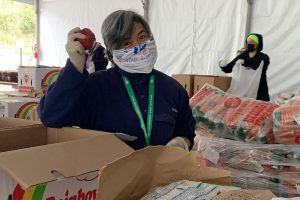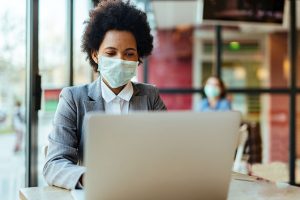
As parts of the country begin to reopen, libraries are slowly restoring services. For many, contactless or curbside pickup is the first service to return, but some have begun opening buildings to staff and visitors.
Both library services and the spaces themselves will look much different from before the pandemic. Changes include limiting capacity and computer use, putting one-way walking markers on floors, requiring both patrons and staff to wear masks, having sanitizer available, installing Plexiglas sneeze guards, and allowing appointment-only entry—all intended to prioritize staff and patron health. Still, many library workers remain concerned about returning to work.
“There are no official guidelines on how to safely reopen libraries,” says Bobbi Newman, speaker and author of the blog Librarian by Day. “The [Centers for Disease Control and Prevention] has some guidelines that are for schools and businesses, but they aren’t library-specific.”
Some libraries are developing their own plans to offer in-person services to patrons. At East Central College Library in Union, Missouri, curbside pickup and technology pickup and returns began April 7. On May 18, students regained access to the building, but to maintain a limited capacity, only those with appointments can enter. Masks are required, and students have access to only 25% of the study areas and computers to ensure safe social distancing. If a student does not have a mask, the library will provide one to them.
According to Director Lisa Farrell, the library followed opening phases suggested by the college, and library services are not likely to change as the school transitions into the summer term.
“We do not expect a huge influx of appointments this summer with all courses being remote,” she says. “July 1 would be the date we could reconsider additional changes. This may allow us to open up the stacks for browsing of students and staff, still by appointment.”
Transitions and test runs
Regardless of a library’s reopening stage, test runs are an essential part of a transition to ensure staff comfort and patron compliance. At Elmhurst (Ill.) Public Library (EPL), the reopening process began with a trial run of their curbside service. The library invited a small group of 10–15 patrons to participate, sending out media advisory forms to better understand the items they wanted. Staff then compiled and pulled books and movies, taking turns staffing the contactless pickup area inside the building’s vestibule.
Alea Perez, head of the children’s department, says library staffers worked together to ensure the safest possible reopening plan: “Throughout the whole conversation, safety was the key component. This is what we were starting with, so that baseline was what we had to make sure happened.”
According to Perez, the library is preparing for a more comprehensive reopening later in the summer.
She and her team are investigating software tools to help patrons set appointments, which will limit building capacity. “We’re trying to find the most seamless way possible to allow patrons in, to keep them at a limit, and to not encourage as much congregating,” she explains.
Other libraries further along in their reopening plans have allowed patrons back inside the building without scheduled appointments. Prescott Valley (Ariz.) Public Library (PVPL) worked with a risk assessor and town management to determine whether it would be safe to reopen to the public. Director Casey Van Haren says that their town’s relatively low COVID-19 numbers allowed them a safer, more expedient path to reopening.

On May 6, PVPL opened its doors to patrons but with some limitations, spelled out in a splash screen on the library’s website that patrons had to see and click through to enter the main website. Only 60 patrons are permitted in the building at a time, and all are encouraged to use masks and gloves. Staffers have removed 22 of the 32 computers in the adult area, and only limited computer assistance is available to help staff maintain physical distancing. Some parts of the library—the digital media lab, the teen art room, and the game room—remain closed, and all returned materials will be quarantined for three days before reshelving. And, for the first week of their reopening, the town required temperature checks for all patrons entering the building.
“Everyone just accepted it,” Van Haren says. “Nobody complained, and we didn’t have to turn anyone away in the whole week that we did the temperature checks.”
But while some libraries and counties are requiring temperature checks, these measures can provide a false sense of security. “If we’re seeing that 35% [of coronavirus carriers] are asymptomatic, you might think you’re in a safe environment, but you’re not,” says Newman. “If a library is taking everyone’s temperature, people will think, ‘This is a safe space, and I don’t have to take part [in the safety measures]’.”
Safety concerns, staff anxiety
Van Haren also says staff remain worried about personal safety and are hesitant to confront patrons who don’t abide by the new library guidelines. “I’ve had a couple confrontations with some patrons who don’t get it,” she says. “We need people to understand, not only for their safety but for the safety of staff, that they need to get what they need and leave.
“It’s scary, but we removed all furniture to prevent people from posting up for hours,” she adds. “We have sneeze guards at all public service points. I want staff to wear gloves any time they’re handling materials. We’re not requiring masks, but most staff wear masks.”
Staff anxiety also played a key role in EPL’s reopening strategy. The curbside service test run required only the library’s director and assistant director to be in the building. The library’s management team has since joined the directors inside the facility while most staff continue to work from home. “We’re trying to make sure that if we ask our staff to do it that we are willing to do it ourselves, too,” says Perez.
Still, some librarians are advocating to postpone reopenings entirely, citing a lack of information and worker safety as primary concerns.
“There hasn’t been enough time for us to know if phased reopenings of any kind are the right choice right now,” says Callan Bignoli, library director at the Olin College of Engineering in Needham, Massachusetts. “It’s creating a false impression that things are safe and that we can go back to normal, but the numbers aren’t showing that.”
Bignoli also notes that libraries are sources of knowledge for their communities. Without clear guidance and an understanding of transmission risk, she says libraries risk spreading false or unverified information: “We’re supposed to provide good, reliable facts. Don’t mislead people.”
While Bignoli’s library’s building remains closed to students, she has been advocating for library worker safety through her role on the executive board of the Massachusetts Library Association. She also developed the #LIBREV(olution) virtual conference on May 4 about staff morale, staff treatment, and library management systems and helped launch a website devoted to protecting library workers. In partnership with the Library Freedom Project, she also created a petition advocating for library worker demands for safe reopenings. The petition is nearing 7,000 signatures.
Newman says that if library staff returning to unsafe work environments are scared, they won’t be able to provide the best service to patrons. “We’re talking about layers upon layers of emotional stress,” she says. “Your patrons are coming into a building full of fear and anxiety rather than what we all like to think of libraries: as calm, welcoming spaces that embrace everybody.”
While each library’s reopening strategy will depend on available resources and area COVID-19 cases, most agree that understanding staff and patron apprehension is essential to a successful transition.
“The biggest challenge is getting staff on board. You have to constantly keep them in the know and be transparent,” says Van Haren. “You can’t hide in your office. You have to be out there on the front lines.”
Perez echoed the sentiment, advocating for administrators to include staff in decisions as much as possible. She says that staff observations and experience are an invaluable tool for management to consider while reopening: “None of us has the answer, but we can work together to find them.”
The American Library Association (ALA) has created a list of resources on reopening for states and individual libraries.


